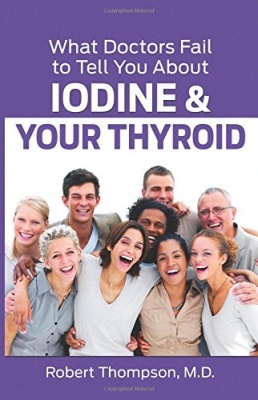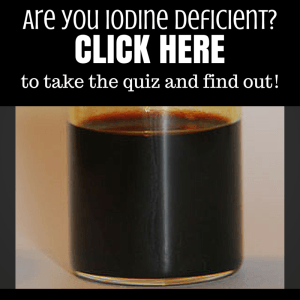Most of us have heard of iodine, but we’d be hard-pressed to recite what it does. If you’re of a certain age, you probably remember your mother dabbing the yellow-brown liquid on a scraped knee and the vicious sting that followed! Maybe you remember that iodine is added to salt. Maybe you can identify iodine as a mineral. But that’s probably just about it for most of us.
Before the widespread use of synthetic drugs and antibiotics, iodine was recommended for everything from healing wounds and disease, destroying bacteria and viruses, to possibly even preventing cancer.
The Nobel laureate Dr. Albert Szent-Györgyi (1893–1986), the physician who discovered vitamin C, wrote:
When I was a medical student, iodine in the form of KI [potassium iodide] was the universal medicine. Nobody knew what it did, but it did something and did something good. We students used to sum up the situation in this little rhyme:
‘If ye don’t know where, what, and why, Prescribe ye then K and I.’
What if I told you that:
- Iodine is found in every single one of your body’s trillions of cells?
- Your hormones need iodine to perform their jobs as chemical messengers in the body?
- Iodine is essential for thyroid function and every part of the cascade of metabolic processes that the thyroid governs?
- Your immune system needs iodine to function?
- It is a powerful antimicrobial that can protect you from the common cold to an infected wound (yes, Mom was right!) to cancer?
- Insufficient iodine levels lead to miscarriages?
- It is necessary for healthy breast tissue?
- Iodine is crucial for brain development in babies?
Iodine is essential to life. Without adequate stores of iodine, eventually, you may die. In the meantime, you can develop a number of diseases that negatively affect quality of life, including:
- Thyroid disease and goiter
- Breast, prostate, ovarian, thyroid, pancreatic and other cancers
- Lack of ovulation and infertility, menstrual disturbances and miscarriages
- Fibrocystic breast disease, ovarian, pancreatic and thyroid cysts, pelvic pain and possibly endometriosis
- Obesity
- Mental retardation and cretinism
- Allergies and asthma
- Parkinson’s disease and other brain disorders
Yet approximately 2 billion people, or one-third of the world’s population, live in areas defined as iodine deficient by the World Health Organization (WHO), including millions in India and China.
While WHO statistics show that about 15% of the world’s population is iodine deficient, Dr. David Brownstein, author of Iodine: Why You Need It, Why You Can’t Live Without It, says that 90% of the 5,000 patients he has tested are iodine insufficient, meaning they have just enough iodine to avoid goiter, but not enough for good health. In 1995, Dr. Brownstein writes, more than half of all pregnant women were iodine deficient. One can only assume that number is higher today.
Here’s a very short list of the scientifically validated health benefits of adequate iodine intake:
- Prevent breast, prostate, ovarian, thyroid and pancreatic cancer
- Maintain a healthy weight, stop food cravings and keep your metabolism high
- Boost energy and libido
- Stop “brain fog” and improve focus
- Improve dry, brittle hair and cracked skin
- Increase IQ in children, especially if given during pregnancy
- Possibly prevent autism
- Improve blood sugar control in people with diabetes
- Reduce the risk of Parkinson’s and Alzheimer’s diseases
Won’t iodized salt do the trick?
It isn’t salt or even sodium that is the problem for people with high blood pressure. Table salt is the nutritional equivalent of white bread. It has most of its minerals removed, some of which, like potassium and magnesium, would otherwise help to balance blood pressure. Consequently, table salt causes blood pressure to fluctuate instead of stabilizing it.
The answer? Unrefined sea salt with all of the minerals we need in balance. Unfortunately, though healthier, sea salt still may not include high levels of iodine, so in most cases, supplemental iodine is required.
The government typically sets our daily requirements for nutrients ridiculously low. In the case of iodine, it’s a bare 150 mcg a day for adults. Typically, we in the United States get a little more than that—about 240 mcg per day—just enough to prevent goiter (an enlarged thyroid gland indicative of iodine deficiency), but not enough for truly beneficial health effects.
There’s nothing scary about getting more iodine in your system. After all, people in Japan consume more than 13 mg—13,000 mcg—of iodine per day just through their diet. That’s 50 times more than the average American, and it hasn’t hurt them a bit. In fact, it’s probably contributed to better health, since we know the rates of breast cancer, fibrocystic breast disease and hypothyroidism are exceptionally low in Japan. What’s more, the people of Okinawa, Japan, who consume as much as 200 mg (200,000 mcg—2,800 times the U.S. government’s recommended daily intake) of iodine a day, are exceptionally long-lived.
–Learn more about iodine, the health consequences of shortfalls and how to correct them in What Doctors Fail To Tell You About Iodine & Your Thyroid by Dr. Robert Thompson, edited by Kathleen Barnes.









interested in the health benefit and more importantly the uses of EnerG-Iodine (Kae Thompson)
I’m not really familiar with the product. I see that it is colloidal. I don’t have experience with it, but I know that Dr. Robert Thompson, my co-author on The Calcium Lie, colloidal minerals are potentially dangerous, depending on the source of the clay form which they are derived and other minerals that may be included,like aluminum, lead and nickel. Since iodine is only minimally present in soil, I don’t know what the source of the colloidal minerals would be. In any case, the recommends form of iodine contains potassium iodide, sodium iodide and molecular iodine from kelp. These in combination protect thyroid and breasts. You might want to ask some more questions of the manufacturer. I hope this helps.